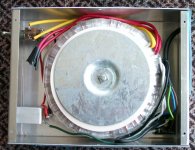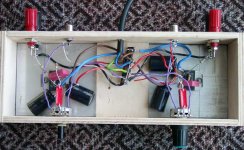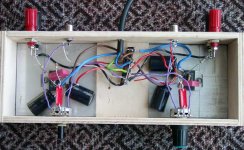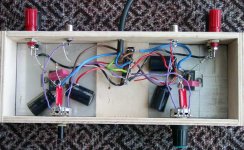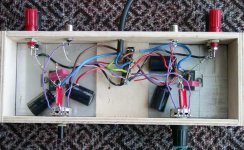I made up a GC using Thorstens circuit and my wife and I have just been comparing it to the 30yr old TA1055.
There was no need to do a blind test, in fact the GC sounded so crappy we both laughed.
The GC was thin and lifeless and the worst of it - no bass at all!
In comparison the TA1055 sounds warm, musical, and delivers bass that you can feel.
The speakers - ML TQWP's - now they ARE worth making.
Awfully sorry chaps but you've been HAD by the HaHa End.
Regards - Jim Read
Thinking about it, I put this post on AMP Chip yesterday, the LM amps are made to amplify the speakers in motorcar door panels and the manufacturers don't want the customers complaining of excessive vibrations.
There was no need to do a blind test, in fact the GC sounded so crappy we both laughed.
The GC was thin and lifeless and the worst of it - no bass at all!
In comparison the TA1055 sounds warm, musical, and delivers bass that you can feel.
The speakers - ML TQWP's - now they ARE worth making.
Awfully sorry chaps but you've been HAD by the HaHa End.
Regards - Jim Read
Thinking about it, I put this post on AMP Chip yesterday, the LM amps are made to amplify the speakers in motorcar door panels and the manufacturers don't want the customers complaining of excessive vibrations.
Dear Jim
Except from the case that the TA 1055 is an exceptionally good amp, and/or the GC you built has some fault, i think you undervalue the gainclone. It is not THE amp, but at the same time it is not as bad as you describe. Try to burn it in for a while and then give it another good listening. May be you have been used to the sound of your amp and the new kid sounds unfamiliar. If the TA 1055 has a bit rolled off highs, you may easily fall to the false assumption that in comparison, GC has no bass. In any case though, feel free to enjoy music with whatever amplifier you feel comfortable with.
PS. Yes, "...the LM amps are made to amplify the speakers in motorcar door panels.." too, but not only. That they are cheap, because they are produced by the millions thanks to the car and TV manufacturers, doesn't mean that they are cheap sounding as well.
Regards
George
Except from the case that the TA 1055 is an exceptionally good amp, and/or the GC you built has some fault, i think you undervalue the gainclone. It is not THE amp, but at the same time it is not as bad as you describe. Try to burn it in for a while and then give it another good listening. May be you have been used to the sound of your amp and the new kid sounds unfamiliar. If the TA 1055 has a bit rolled off highs, you may easily fall to the false assumption that in comparison, GC has no bass. In any case though, feel free to enjoy music with whatever amplifier you feel comfortable with.
PS. Yes, "...the LM amps are made to amplify the speakers in motorcar door panels.." too, but not only. That they are cheap, because they are produced by the millions thanks to the car and TV manufacturers, doesn't mean that they are cheap sounding as well.
Regards
George
Since you posted a pic of your ML TQWP speakers, maybe you could post a pic of your gainclone and we could see what might go wrong. It doesn't seems that too many builders are so dissatisfied with their clones (like you are), so maybe something indeed went wrong when you were building it.😉
Jim Read said:Thinking about it, I put this post on AMP Chip yesterday, the LM amps are made to amplify the speakers in motorcar door panels and the manufacturers don't want the customers complaining of excessive vibrations.
Just which LM amp did you use for your GC? The LM chips used in the GCs are most commonly 3886, 3875, 3876 and 1875 as well as some OPA5xx. AFAIK, none of these are designed or even suitable for car amplifiers for speakers in door panels (which in itself is a really strange statement). The app note say High-End Stero TVS, Compact or Component stereos, Surround Sound amplifiers and Self-Powered speakers. Not much mentioned about cars. However for things like ST TDA7xxx series that would be true since they are designed for supply at 14.4 V max which none of the standard (or what I see as standard) chips in GCs are.
I myself found my GC playing better than my DENON 2800 amplifier without any hesitation and I am very sceptical about claims like for the GCs.
I wonder what may have gone wrong with your set-up. Please post some details and we might be able to help.
Lets not forget that GC is not particularly good driving difficult loads and can sound compressed and bass light with the wrong speakers. Under such circumstances it may well sound as Jim describes it. Then there is also the issue of individual sonic preference. A good friend of mine, proud owner of a huge Yamaha amp has never liked any of my amps ever. The Yamaha bass is capable of rearranging the furniture with little provocation and simply offers a different physical experience to wimpy SETs and gainclones. One size certainly doesn't fit all.
cheers
peter
cheers
peter
Re: power supply pic
Kuei Yang Wang
One Bridge? Not my Circuit. Your circuit.
As for the Sony, I hope you turned Loudness off and bypassed the tone controls, so that you are comparing the Amplifiers and no the presence and absence of Frequency response shaping.
Sayonara
Kuei Yang Wang
Jim Read said:The transformer is 34-0-34V 200VA, 50 amp bridge, and a 'smoothed' Euro socket
One Bridge? Not my Circuit. Your circuit.
As for the Sony, I hope you turned Loudness off and bypassed the tone controls, so that you are comparing the Amplifiers and no the presence and absence of Frequency response shaping.
Sayonara
Re: power supply pic
If that's the AC voltage on a transformer, it seems pretty high by usually accepted standards, 24-0-24 is much more appropriate.
Jim Read said:The transformer is 34-0-34V 200VA, 50 amp bridge, and a 'smoothed' Euro socket
If that's the AC voltage on a transformer, it seems pretty high by usually accepted standards, 24-0-24 is much more appropriate.
With that transformer your exceeding the maximum supply voltage by 5VDC per rail and probably driving the amp well outside it's optimum range for optimum THD+N operation. You can find the specs at http://www.national.com/ds/LM/LM3875.pdf.
As Peter recommends, staying on the low side of the recommend voltage range seems to provide the best sound.
As Peter recommends, staying on the low side of the recommend voltage range seems to provide the best sound.
Re: pic of the amp
Koinichiwa,
And something I overlooked. If you Mains transformer is really 34V-0-34V you are very likely triggering the IC's over Voltage protection. The absolute MAXIMUM secondary Voltage I recommend is 24/25V and that is borderline already in the UK with maximum tolerance high mains voltage.
With 34V-0-34V and 7% regulation as well as a 230V primary Mains Transformer on the UK 240V mains you get approximatly +/-52V power supply Voltages. ABSOLUTE MAX rating with no signal is +/-47V and with Signal +/-42V!!!! If the PSU voltages are notably higher than that the overvoltage protection circuit will cut in. The result should sound awful.
What 0.1uF? I never specified 0.1uF. And are you sure it has the voltage rating to withstand the Supply voltage, Tantalum usually does not come in 100V or higher?
And by non-polarised you hopefully do not mean non-polarised electrolytic capacitors. What did you use as PSU Capacitors?
Anyway, it seems to me that you have changed a few things that in my view are absolutely essential and quite possibly have actually made an non-functioning Amplifier.
Sayonara
Koinichiwa,
Jim Read said:The transformer is 34-0-34V 200VA, 50 amp bridge, and a 'smoothed' Euro socket
And something I overlooked. If you Mains transformer is really 34V-0-34V you are very likely triggering the IC's over Voltage protection. The absolute MAXIMUM secondary Voltage I recommend is 24/25V and that is borderline already in the UK with maximum tolerance high mains voltage.
With 34V-0-34V and 7% regulation as well as a 230V primary Mains Transformer on the UK 240V mains you get approximatly +/-52V power supply Voltages. ABSOLUTE MAX rating with no signal is +/-47V and with Signal +/-42V!!!! If the PSU voltages are notably higher than that the overvoltage protection circuit will cut in. The result should sound awful.
Jim Read said:LM3875, carbon resistors, non-polarised caps except for the 0.1 uf across the power supply which is a tantalum bead. Two carbon track pots and star earth.
What 0.1uF? I never specified 0.1uF. And are you sure it has the voltage rating to withstand the Supply voltage, Tantalum usually does not come in 100V or higher?
And by non-polarised you hopefully do not mean non-polarised electrolytic capacitors. What did you use as PSU Capacitors?
Anyway, it seems to me that you have changed a few things that in my view are absolutely essential and quite possibly have actually made an non-functioning Amplifier.
Sayonara
I guess building it with unsuitable components and exceeding specs by a large margin could lead to nowherenear perfect sound...
Please verify the above about the transformer and components.
Please verify the above about the transformer and components.
Aaaaargh
Can't load any more pics don't know why the 1st one did.
I'm goin back to listenin to the music and not the equipment, with my lovely Sony!
Bye
Can't load any more pics don't know why the 1st one did.
I'm goin back to listenin to the music and not the equipment, with my lovely Sony!
Bye
Koinichiwa,
I see three things that I'd note.
1) Ground routing - no dual mono as recommended and no seperate windings, this must lead to "dirty" ground
2) Output Resistor is 1/4 W Type (or thereabouts). Not good.
3) From what I can see the RC circuit on the non-inverting Input is not present, this may cause excessive offset which with a speakerload may heat up the chip too much.
Further, if the rails are at the kind of voltages I suspect they are at the PSU Cap's and the Chip are near or above absolute limits.
For one thing I would like to say is that I have to disown this gainclone as being "according to Thorstens Design". It is not. It is according to Jim's design and in a number of key areas seriously problematic.
Sayonara
Peter Daniel said:Here's Jim's gainclone. I asked him to e-mail the pic to me, so I could post it for him🙂
It's looking pretty good and if there are any problems with sound, it may be because of too high rails, indeed.
I see three things that I'd note.
1) Ground routing - no dual mono as recommended and no seperate windings, this must lead to "dirty" ground
2) Output Resistor is 1/4 W Type (or thereabouts). Not good.
3) From what I can see the RC circuit on the non-inverting Input is not present, this may cause excessive offset which with a speakerload may heat up the chip too much.
Further, if the rails are at the kind of voltages I suspect they are at the PSU Cap's and the Chip are near or above absolute limits.
For one thing I would like to say is that I have to disown this gainclone as being "according to Thorstens Design". It is not. It is according to Jim's design and in a number of key areas seriously problematic.
Sayonara
Thanks for loading the pic Peter
In answer to some of the points raised, the sensible ones, some people on this forum can't even read a circuit diagram and certainly don't read the posts properly.
1/ The circuit is THORSTENS, go to AMP Chip and click the logo! The person who calls him/herself Sayonara will see the 0.1uf cap in RED.
2/ I accept that the power supply may a bit over the top, but there was no sign of the amp cutting out, I assume it would be some sort of motorboating effect that gradually ended with a complete shutdown.
3/ The Sony amp cost me £3.00 ($5.00). Type 'Sony TA1055' into Google to read the rest of the story. I did make sure that the loudness control was OFF, in fact it's never ON, the tone controls are set at zero.
4/ The 'Load' is a 5.1/4" 45W, 92db FR driver with the whizzer removed in a BD ML TQWP enclosure though I got the drawing off the SOLO site. Probably the easiest load for any amp.
5/ Most of the criticism's are just nit picking and would not substantially alter the basic sound of the amp and have not addressed this; the amp in Gaincard format costs, using one power supply and two amps about 4,500 £ or $, the so called Hi-End wrote rave reviews of it, yet it doesn't come anywhere near my TA 1055, I would have AT THE VERY LEAST expected it to sound the same and then get better. It doesn't!
Having read all the articles, reviews and posts on various forums I was very enthusiastic about making the amp. Having experienced the actuality I am reminded of my old Pentax S1a which I still use, I saw the reviews for the Olympus OM4 and was seduced into buying one, I sold it some months later at a loss, the lens was rubbish in comparision to the Takumar one in every way.
Now I shall definately go back to listening to the music and not the equipment.
Byebye and kind regards - Jim 🙂
ps my pics did post you've four now I think
In answer to some of the points raised, the sensible ones, some people on this forum can't even read a circuit diagram and certainly don't read the posts properly.
1/ The circuit is THORSTENS, go to AMP Chip and click the logo! The person who calls him/herself Sayonara will see the 0.1uf cap in RED.
2/ I accept that the power supply may a bit over the top, but there was no sign of the amp cutting out, I assume it would be some sort of motorboating effect that gradually ended with a complete shutdown.
3/ The Sony amp cost me £3.00 ($5.00). Type 'Sony TA1055' into Google to read the rest of the story. I did make sure that the loudness control was OFF, in fact it's never ON, the tone controls are set at zero.
4/ The 'Load' is a 5.1/4" 45W, 92db FR driver with the whizzer removed in a BD ML TQWP enclosure though I got the drawing off the SOLO site. Probably the easiest load for any amp.
5/ Most of the criticism's are just nit picking and would not substantially alter the basic sound of the amp and have not addressed this; the amp in Gaincard format costs, using one power supply and two amps about 4,500 £ or $, the so called Hi-End wrote rave reviews of it, yet it doesn't come anywhere near my TA 1055, I would have AT THE VERY LEAST expected it to sound the same and then get better. It doesn't!
Having read all the articles, reviews and posts on various forums I was very enthusiastic about making the amp. Having experienced the actuality I am reminded of my old Pentax S1a which I still use, I saw the reviews for the Olympus OM4 and was seduced into buying one, I sold it some months later at a loss, the lens was rubbish in comparision to the Takumar one in every way.
Now I shall definately go back to listening to the music and not the equipment.
Byebye and kind regards - Jim 🙂
ps my pics did post you've four now I think
- Status
- Not open for further replies.
- Home
- Amplifiers
- Chip Amps
- Gainclone vs Sony TA1055
